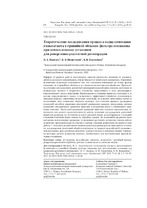| dc.contributor.author | Иванова, И. Е. | ru |
| dc.contributor.author | Ивашечкин, В. В. | ru |
| dc.contributor.author | Веременюк, В. В. | ru |
| dc.coverage.spatial | Минск | ru |
| dc.date.accessioned | 2018-01-24T07:23:28Z | |
| dc.date.available | 2018-01-24T07:23:28Z | |
| dc.date.issued | 2018 | |
| dc.identifier.citation | Иванова, И. Е. Теоретические исследования процесса выщелачивания кольматанта в гравийной обсыпке фильтра скважины при использовании установки для реверсивно-реагентной регенерации = Theoretical studies of the leaching process of the mudding element in the gravel package of the well filter using the unit for reverse-reagent regeneration / И. Е. Иванова, В. В. Ивашечкин, В. В. Веременюк // Энергетика. Известия высших учебных заведений и энергетических объединений СНГ. - 2018. - № 1. - С. 80-92. | ru |
| dc.identifier.uri | https://rep.bntu.by/handle/data/36813 | |
| dc.description.abstract | В процессе работы водозаборных скважин происходит снижение их удельного дебита в результате механического, биологического и химического кольматажа. Извлечение кольматанта из фильтра осложняется тем, что отложения охватывают не только фильтр скважины, но и гравийную обсыпку и не удаляются полностью при обработках. Предложена установка для реверсивно-реагентной регенерации водозаборных скважин, состоящая из компрессора, шлангов и погружного устройства, выполненного в виде двухкамерного пневматического насоса вытеснения. Преимуществом установки являются отсутствие в ее составе циркуляционного насоса и возможность эффективной обработки ограниченного интервала фильтра. Скважинное погружное устройство не содержит движущихся частей за исключением двух плавающих обратных клапанов. Для описания процесса растворения отложений способом реверсивно-реагентной регенерации скважин использована система уравнений: объединенного уравнения движения и сохранения массы и обобщенного уравнения кинетики. Путем интегрирования уравнения кинетики получена аналитическая зависимость для расчета продолжительности работы установки для реверсивно-реагентной обработки фильтров, по истечении которой удельный объем кольматирующих отложений в гравийной обсыпке будет снижен до заданного уровня. По полученным формулам была составлена компьютерная программа, позволяющая рассчитать количество циклов работы устройства, продолжительность очистки и степень удаления кольматанта на каждом этапе работы. С помощью разработанной компьютерной программы рассмотрена работа установки для реверсивно-реагентной обработки фильтров на примере водозаборной скважины с использованием двух различных реагентов: соляной кислоты и дитионита натрия. Приведена методика расчета количества реагента, необходимого для восстановления производительности скважин. | ru |
| dc.language.iso | ru | ru |
| dc.publisher | БНТУ | ru |
| dc.subject | Regeneration | en |
| dc.subject | Water well | en |
| dc.subject | Mudding element | en |
| dc.subject | Gravel filter | en |
| dc.subject | Reverse-reagent treatment | en |
| dc.subject | Reagent | en |
| dc.subject | Hydrochloric acid | en |
| dc.subject | Sodium dithionite | en |
| dc.subject | Регенерация | ru |
| dc.subject | Водозаборная скважина | ru |
| dc.subject | Кольматант | ru |
| dc.subject | Гравийный фильтр | ru |
| dc.subject | Реверсивно-реагентная обработка | ru |
| dc.subject | Реагент | ru |
| dc.subject | Соляная кислота | ru |
| dc.subject | Дитионит натрия | ru |
| dc.title | Теоретические исследования процесса выщелачивания кольматанта в гравийной обсыпке фильтра скважины при использовании установки для реверсивно-реагентной регенерации | ru |
| dc.title.alternative | Theoretical studies of the leaching process of the mudding element in the gravel package of the well filter using the unit for reverse-reagent regeneration | en |
| dc.type | Article | ru |
| dc.identifier.doi | 10.21122/1029-7448-2018-61-1-80-92 | |
| local.description.annotation | During the operation of water wells, their specific production rate is reduced as a result of mechanical, biological and chemical colmatage. The extraction of the mudding element from the filter is complicated by the fact that the deposits cover not only the well filter, but also gravel package and are not completely removed by the treatment. An installation is proposed for reversereagent regeneration of water wells, consisting of a compressor, hoses and submersible device in the form of a two-chamber pneumatic displacement pump. The advantage of the unit is the absence of a circulating pump in its composition and the possibility of efficient processing of the limited filter interval. The downhole submersible device does not contain moving parts except for two floating check valves. In order to describe the process of dissolution of deposits by the method of reverse-reagent water well regeneration, a system of equations is used: the combined equation of motion and mass conservation and the generalized equation of kinetics. By integrating the kinetics equation, an analytical dependence is obtained to calculate the operating time of the unit for reverse-reagent filter regeneration, followed by the reducing of the specific volume of the colmatizing deposits in the gravel package to a predetermined level. According to the formulas obtained, a computer program was compiled, which allows calculating the number of operating cycles of the device, the duration of cleaning and the degree of removal of the colmatant at each stage of the work. With the aid of the developed computer program, the operation of the unit for reverse-reagent filter regeneration is considered on behalf of a water well using two different reagents: hydrochloric acid and sodium dithionite. The procedure for calculating the amount of reagent needed to restore water well productivity is presented. | en |

